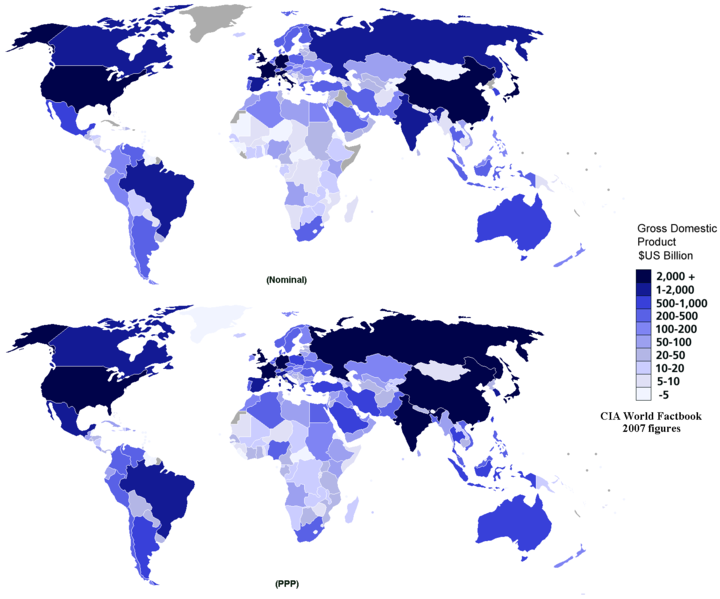The World’s Largest Economies
Please note that we are not authorised to provide any investment advice. The content on this page is for information purposes only.
Emerging economies are smaller than the developed countries – but they are growing faster and opening up, leading to greater investment opportunities than ever before.
There are two methods of GDP calculation: nominal GDP attempts to compare countries using current exchange rates to give an assessment of their clout within the global market. This naturally biases countries with stronger currencies.
Emerging economies are smaller than the developed countries – but they are growing faster and opening up, leading to greater investment opportunities than ever before.
There are two methods of GDP calculation: nominal GDP attempts to compare countries using current exchange rates to give an assessment of their clout within the global market. This naturally biases countries with stronger currencies.
Purchasing Power Parity or PPP GDP, on the other hand, tries to take into account that one dollar can buy more in some countries and less in others. It is a better gauge of the internal size of each market.
In the nominal GDP method, we can see that the developed world leads the pack, but that China has already broken into this exclusive club, and is now the second largest economy in the world by both measures.
When we look at PPP GDP, all of the BRIC countries (China, India, Brazil and Russia) are all within the top 10.
Here is the Top 10, as listed by PPP GDP, using 2010 GDP figures:
| Ranking | Country | Approximate GDP- Purchasing Power Parity |
| 1 | United States of America | $14,624,180,000,000 (that is $14.6 trillion dollars if you are trying to count zeros) |
| 2 | China | $10,084,370,000,000 |
| 3 | Japan | $4,308,630,000,000 |
| 4 | India | $4,001,100,000,000 |
| 5 | Germany | $2,932,040,000,000 |
| 6 | Russia | $2,218,760,000,000 |
| 7 | Brazil | $2,181,680,000,000 |
| 8 | United Kingdom | $2,181,070,000,000 |
| 9 | France | $2,146,280,000,000 |
| 10 | Italy | $1,771,140,000,000 |
While the US is still the world’s dominant economy, and central to the global economic system thanks to the simple fact that the US dollar is the world’s reserve currency (ie the currency that we all need in order to trade), we can clearly see that China’s clout is rapidly growing. The numbers tell the story not just of the BRIC, but also the G2 or Chamerica, as some are calling the US/ China combo.
[break]Which Economies Will Be Top by 2015?
In the last few years we have also seen India overhaul Germany, and Russial and Brazil overtake the UK.
Indeed, according to current forecasts, by 2015 India will have overtaken Japan to be the third most important economy in the world, and Mexico will have entered the Top Ten – and kicked Italy out of that exclusive club,
To give us a better global view, this map from the CIA World Factbook will help to illustrate the differences between calculating world GDP figures on a PPP or nominal basis.
A sectoral analysis of country GDP allows us to understand the paradigm shift now occurring within most world economies. Growth patterns generally show a shift from agriculture to manufacturing and ultimately to the services sector.
The following table shows the percentage of GDP contributed by each sector in the top ten economies of the world:
| Country | Contribution of Services Sector in GDP (estimated for 2007) | Contribution of Industrial Sector in GDP | Contribution of Agricultural Sector in GDP |
| United States of America | 78.5% | 20.6% | 0.9% |
| China | 39.5% | 49.5% | 11% |
| Japan | 73.3% | 25.2% | 1.5% |
| India | 55% | 28.4% | 16.6% |
| Germany | 69.5% | 26.9% | 0.9% |
| United Kingdom | 75.5% | 23.6% | 0.9% |
| Russia | 56.3% | 39.1% | 4.6% |
| France | 77.3% | 20.7% | 2% |
| Brazil | 64% | 30.8% | 5.1% |
| Italy | 69.3% | 32% | 5% |
The growth rate of these economies is also an important factor, and is directly related to the overall development of a specific economy. Group of Seven Countries such as the United States, France, Italy and the United Kingdom all typically have smaller growth rates – usually in the region of about 2% per annum.
By contrast, emerging economies such as India and China have growth rates of around 8% to 11%, while the ‘new’ emerging economies may experience even more blistering growth rates. Developed countries have already reached a saturation point, and thus expand less than emerging economies, where possibilities and opportunities are ripe, investors are ready to take risks, and consumers are demanding more goods and services than ever before.





